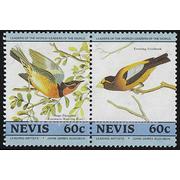When I was a wee lad, flocks of these noisy yellow finches routinely filled my yard. Through the ’80s and early ’90s, they cost me a fortune in sunflower seeds. Even though they were avian vacuum cleaners at my feeder, I cherished them for their gregarious cheerfulness. Originally, this was a western bird. It was abundant in the Columbia River Basin in the 1830s, where it was originally studied by early scientists. The first record of a Maine sighting was in 1890. Until the 1900s, it was not known to be nesting anywhere east of the Great Lakes. In 1926, the first confirmed breeder in New England was discovered in Vermont. The next nesting pair in Vermont wasn’t noted until 1953. Soon thereafter, it was an abundant feeder bird across northern New England, with populations peaking in the early 1970s. It’s been downhill ever since. The evening grosbeak (Coccothraustes vespertinus) uses its big bill to open big seeds. It’s strong enough to crack a cherry pit. However, growing babies need protein, so nestlings are routinely fed grubs and larvae. One theory for the decline is that the population rose and fell with the spruce budworm. There are several other northern forest species whose numbers also increased when the budworm and its larvae furnished abundant food.
Source: By Bob Duchesne, Special to the Bangor Daily News. Posted March 02, 2012.
http://bangordailynews.com/2012/03/02/outdoors/rise-and-fall-of-evening…
Spruce budworms and relatives are a group of closely related insects in the genus Choristoneura. Most are serious pests of conifers. The neonicotinoid insecticide Imidacloprid is recommended in the US for the control of aphids in conifers. It is conceivable the population of spruce budworms may have been reduced by the use of insecticides, depriving evening grosbeaks of an essential food source to raise their young.
Sources: Wikipedia
http://en.wikipedia.org/wiki/Spruce_Budworm
and
http://www.farmlandbirds.net/en/content/imidacloprid-recommended-insect…

- Login om te reageren
